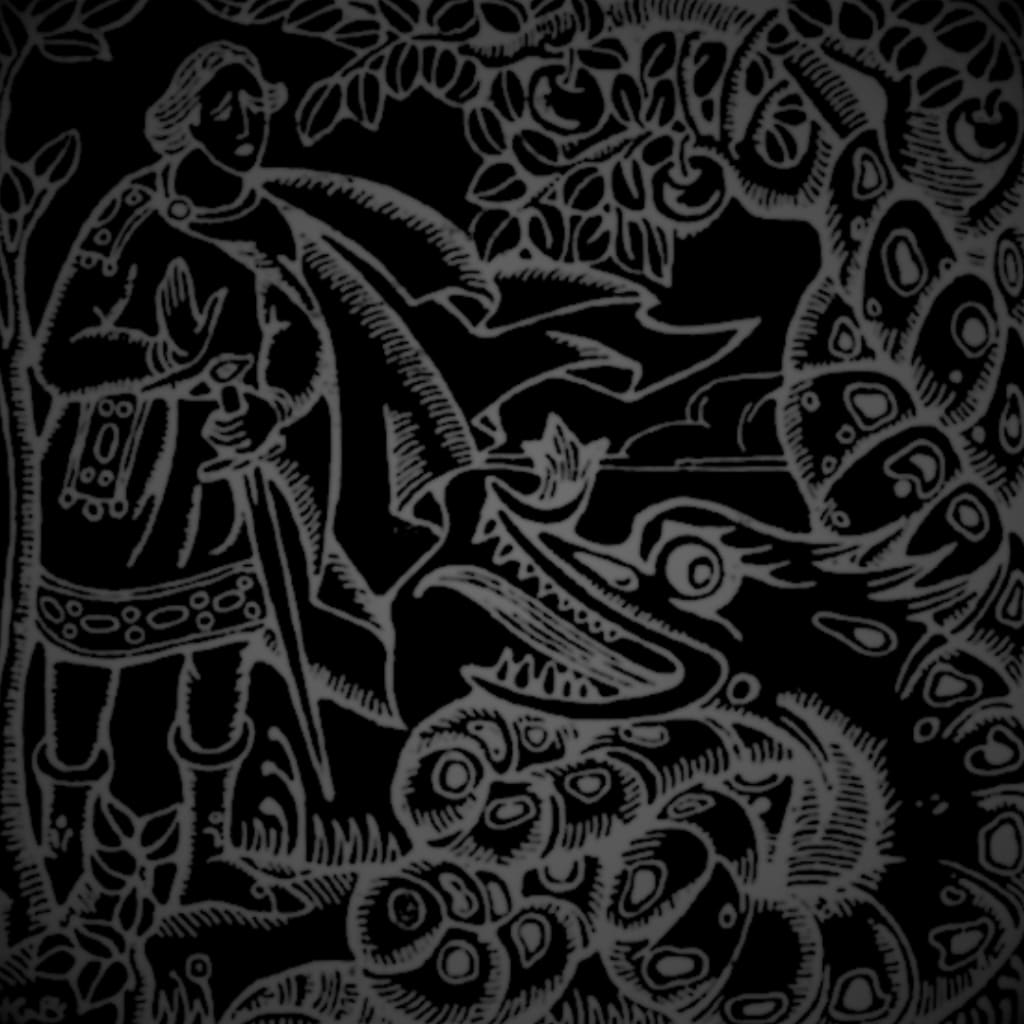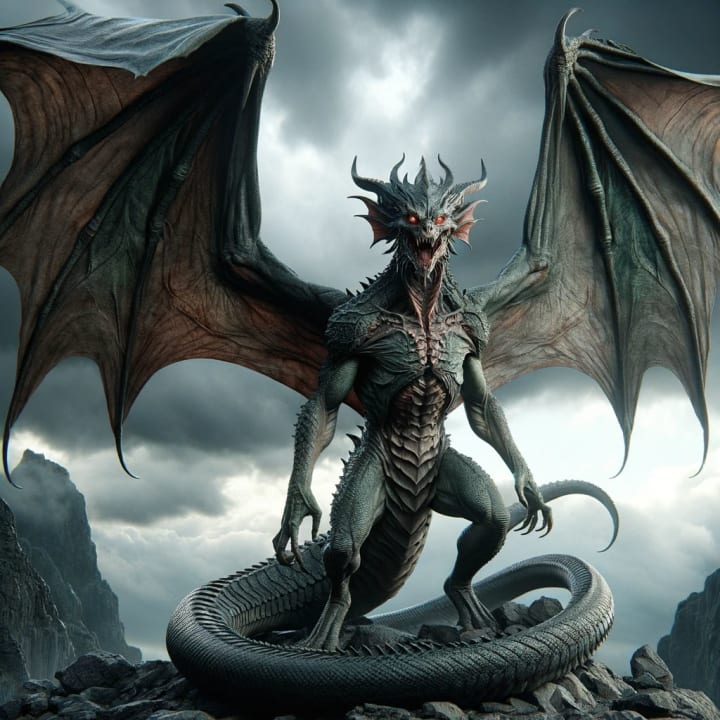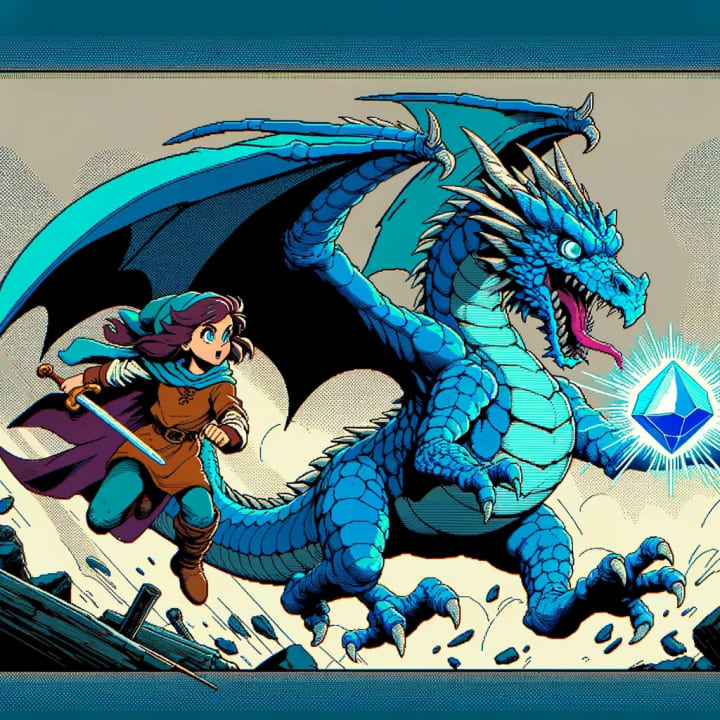Zmeu of Romanian Folklore
An ogre? Devil? Vampire? A dragon that can magically make weapons to murder you with? Yes, all in one creature.

A strange being in Romanian and Slavic folklore defies typical categorization and description: the Zmeu. It comes from Romanian and Slavic folklore, cultures rich in tales of magic and the supernatural, with creatures often deadly to humans.
Stories of the Zmeu blend elements from diverse cultural landscapes distinctly from Eastern European folklore. Adding to the complexity of unraveling the Zmeu is its occasional conflation with the Russian Zmei, another dragon-like creature from Slavic mythology. The Zmeu is a shapeshifter, and its physical descriptions vary from story to story, sometimes appearing dragon-like and sometimes eerily human.
Origin of the Word Zmeu
There's no true consensus on the word's origin, but tracking the etymology of the word Zmeu provides a glimpse into Proto-Slavic and Romanian folklore, culture, and language. The word's roots can be traced back to when myth and legend were integral to understanding the world.
Pronunciation of Zmeu.
Some linguists believe Zmeu originates from the Proto-Slavic term zmey, which refers to a dragon or serpent-like creature. The Proto-Slavic culture predates the split into various Slavic languages and cultures. In the early Proto-Slavic narratives, dragons and serpentine beings are thought to symbolize primal forces of nature. After the Proto-Slavic language branched into the different Slavic languages, the concept of zmey may have evolved into a unique take within each culture.
In Russian and East Slavic traditions, the zmey may have become zmei, a term associated with both benevolent and malevolent dragons.
The Romanian Zmeu, linguistically and conceptually linked to its Slavic counterpart, might have been influenced by traditions different from the Russian and East Slavic ones. A fusion of cultural influences, including Dacian, Roman, Slavic, and later Ottoman and Hungarian, shaped the Zmeu into a being with more nuanced complexity than a typical dragon archetype.
Classic Gothic literature was heavily influenced by Eastern European folklore, which you can clearly see in works like Dracula by Bram Stoker (1897), Carmilla by Sheridan Le Fanu (1872), The Castle of Otranto by Horace Walpole (1764), The Golem by Gustav Meyrink (1915), and The Vampire by Aleksey Konstantinovich Tolstoy (1841).
The Zmeu of Romanian stories is often depicted with a blend of human and supernatural qualities, making for a creature that stands out in folklore. It is more than an embodiment of natural forces, more than a moral allegory; it's a character with ambiguous motivations.
Considering the blend of traditions I mentioned, it's easy to see why the Zmeu defies typical categorization and simple definition. So, given the complex origins...
What is a Zmeu?
Depending on where the story originates, there's a distinct split in descriptions of the Zmeu. In some, the Zmeu resemble dragons, destructive and feared, sometimes benevolent, and at times even guarding treasures or knowledge. There are even some descriptions of the Zmeu with a luminous gemstone in its head.

Other stories describe the Zmeu as anthropomorphized, more humanoid, highly intelligent, cunning, and capable of speech. And, unlike the more dragon-like descriptions, these Zmeu interact with humans in ways that are more than simply terrorizing them; they sometimes form relationships.

Some descriptions say that the Zmeu is like a human body covered in scales, possessing a snake's tail and large bat-like wings, and other accounts say it's more of a bird's body with a human head and snake tail.

In still other tales, the Zmeu is described as a giant human (sometimes with a rocky tail) that eats normal-sized humans. And, to confuse matters even more, another description says a slightly taller, thicker-bodied human.
Really, though, it's the stories of Zmeu that stand out.
Tales of Zmeu
Here are two well-known stories of Zmeu that illustrate just how different the creature may appear.
The first tale, The Story of Făt-Frumos and the Zmeu, comes from Romanian folklore. It's about Făt-Frumos, an archetypal hero who often encounters a Zmeu in his adventures.
The second tale, The Golden Apple and the Nine Peahens, comes from Slavic folklore, and it's about a king and his three sons. In versions of this story, the Zmeu is often depicted as a dragon or a giant.
Făt-Frumos
"Făt-Frumos" is a term from Romanian folklore, and it translates roughly to "Handsome Son" or "Beautiful Youth." The term "Făt" refers to "son" or "youth," and "Frumos" means "handsome" or "beautiful." In Romanian myths and fairy tales, Făt-Frumos is the archetype of the hero, often characterized by his bravery, strength, and virtue. He is typically the central figure in these stories, embarking on quests and overcoming various challenges, often for justice, love, or the pursuit of righting wrongs. His character resembles the "Prince Charming" archetype in many Western fairy tales.
Pronunciation of Făt-Frumos
The Story of Făt-Frumos and the Zmeu
In the land of rolling hills and deep forests, where the line between myth and reality is as thin as a spider's silk, a young prince named Făt-Frumos lived. He was the pride of his kingdom, known for his bravery, kindness, and unwavering sense of justice. Făt-Frumos's life was peaceful and prosperous until a great calamity befell the land.
One fateful evening, under a moonlit sky, a terrible Zmeu, a fearsome creature, both dragon and man, descended from the clouds. With its fiery breath and immense strength, it wreaked havoc upon the kingdom, stealing away the most precious treasure of the realm—the king's beautiful daughter, the beloved princess.
The kingdom was thrown into despair, but Făt-Frumos, burning with righteous fury, vowed to rescue the princess and restore peace. He embarked on his quest, riding his trusty steed, armed with nothing but his courage and a magical sword given to him by a wise hermit.
Făt-Frumos journeyed through enchanted forests, crossed treacherous mountains, and faced numerous trials. He battled fierce beasts and overcame cunning traps laid by the Zmeu, each challenge testing his resolve and bravery.
Finally, Făt-Frumos reached the Zmeu's lair, a dark castle hidden in the clouds, guarded by nightmarish creatures. The Zmeu, seeing the young prince, laughed a thunderous laugh and challenged him to combat, confident in its own invincibility.

The battle was fierce and long. The Zmeu's strength was unmatched, its skin impervious to mortal weapons. But Făt-Frumos, guided by his pure heart and the wisdom of his ancestors, found the creature's weakness. With a mighty blow from his magical sword, he struck the Zmeu down, its fiery breath extinguishing like a candle in the wind.
Făt-Frumos freed the princess from her enchanted prison, and together, they journeyed back to the kingdom. The land rejoiced at their return, celebrating the fall of the Zmeu and the bravery of Făt-Frumos.
The story of Făt-Frumos and the Zmeu became a legend, a tale told and retold through generations. It reminded the people of the power of courage and righteousness, the eternal struggle between light and darkness, and the hero within each heart that dares to stand against the world's dragons.
The Golden Apple and the Nine Peahens
Once upon a time, in a realm woven from the threads of dreams and the whispers of the night, there lay a magnificent kingdom. In the heart of this kingdom stood a grand palace, home to a wise and benevolent king. This king had a garden, famed throughout the lands, where he grew a tree that bore golden apples.
Every morning, the king would find that one apple had been taken during the night. Intrigued and troubled by this mystery, the king entrusted the task of discovering the thief to his three sons. The two elder princes took their turns but, succumbing to sleep, failed to solve the mystery. On the third night, it was the youngest prince's turn. Unlike his brothers, he stayed vigilant throughout the night.
As the moon reached its zenith, the prince witnessed a marvel. Nine radiant and otherworldly peahens flew into the garden, their feathers shimmering like starlight. Eight of them settled to feast upon the fruits, but the ninth, more splendid than the rest, transformed into a beautiful princess and picked a single golden apple.
Struck by her beauty and grace, the prince fell instantly in love. The next night, he decided to follow the peahens. His quest led him to a distant land, where the peahens disappeared into a shimmering lake. Eager to find the princess, the prince sought the counsel of an old, wise woman.
Guided by her wisdom, he traveled to a mountaintop, where he found a magical horse and a set of splendid armor. Armed with these, the prince set off to find the princess. He journeyed far and wide, facing trials that tested his courage and resolve. Eventually, he discovered a magnificent palace where the princess lived.
However, this palace was under the shadow of a fearsome Zmeu, a cunning and powerful creature. The Zmeu had enchanted the princess, binding her to his will. Undeterred, the prince, with the help of his magical horse, confronted the Zmeu in a battle that shook the heavens. The fight was long and perilous, but the prince's pure heart and bravery triumphed. With the Zmeu defeated, the enchantment was broken.
The princess, now free, revealed her true form as the Queen of the Peahens. Grateful and filled with love, she agreed to return with the prince to his kingdom. Their return was met with great joy and celebration. The prince and the Queen of the Peahens were married, and their love brought peace and prosperity to the land.
The story of the Golden Apple and the Nine Peahens, with its trials, triumphs, and the defeat of the Zmeu, became a tale told through the ages. It reminded those who heard it of the enduring power of love, the bravery in every heart, and the magic that dances beneath the surface of our world.
Or, you know, maybe it's all 100% factual, and the entire idea that these stories are metaphors for morality is entirely false. Wouldn't that be interesting?
Legacy of Zmeu
Both of these stories are rich in symbolism and contain moral lessons. The Zmeu represents chaos, evil, or a challenge to be overcome by the hero. These tales have been told and retold through generations, often with variations in different regions. They are integral parts of the cultural heritage of these areas, reflecting the values, fears, and aspirations of the people who tell them.
However, these aren't the only tales of the Zmeu. Not by a long shot. There are so many stories of the Zmeu told throughout different regions of Eastern Europe, each with its own unique twists and descriptions of the Zmeu. The broad range of stories leaves the Zmeu somewhat of an enigma, as it can't quite be pinned down into anything specific unless you look at it from a more local cultural standpoint.
It's important to preserve stories like these, as they are not only remnants of the past but also living narratives that continue to shape our understanding of the world around us. Tales from our ancestors carry hope, fears, and wisdom through generations, and by keeping them alive, we retain a vital link to our own history.
Relevant & Related
- Mirela Roznoveanu wrote a short book on Old Romanian Fairy Tales with illustrations.
- Author Natalie Kononenko has a book where you can explore more Slavic folklore.
- Learn more about Żmij/Zmey - Dragons of Slavic Mythology - Slavic Saturday with author Brendan Noble.
The landscape where stories of the Zmeu originate is pretty amazing, and if you take a close look, it's easy to imagine why the folklore from the area is so unique. Here are a few interesting places in the region:
Noroioși de la Pâclele Mici—The Berca Mud Volcanoes of Buzău County, Romania: Located in Buzău County, these mud volcanoes are a fascinating geological and tourist attraction. They are created by the eruption of gases and mud resulting from natural gas deposits beneath the surface. The landscape they create is often likened to a Martian scene, with small cones of mud rising from the ground. See photos and read more in Berca mud volcanoes Romania.
Pobiti Kamani—The Stone Forest, Bulgaria: This natural rock phenomenon is located near Varna. The site has many stone pillars, some as high as 10 meters. These pillars are not man-made but are natural formations created over millions of years, and their origin is still a subject of scientific debate. See photos and read more in Bulgaria: A Walk in a Stone Forest.
Scărișoara Cave—The Ice Cave in the Apuseni Mountains, Romania: Located in the Scarisoara Glacier, this ice cave is one of the largest of its kind in Romania and one of the oldest in the world. Inside, visitors can see impressive ice formations, including giant ice stalagmites. The cave's microclimate contributes to the preservation of this ancient ice. See photos and read more in Scărișoara Cave.
Đavolja Varoš—Devil's Town, Serbia: Known locally as Đavolja Varoš, this site features peculiar rock formations—over 200 stone pillars created by erosion, standing tall with caps of andesite rock. The formations are accompanied by local legends and myths, adding to the place's mystique. See photos and read more in The Devil's Town, a natural phenomenon in Serbia.
Salina Turda—The Turda Salt Mine, Romania: This is one of the oldest salt mines in the world and is now a unique underground attraction. The mine, dating back to Roman times, has been transformed into an underground amusement park featuring a Ferris wheel, mini-golf, and even a boating lake. The excavated chambers' vastness and the salt formations' beauty are sights to behold. See photos and read more at Salina Turda.
You might enjoy these other articles:
- Vântoase of Romanian Folklore
- Lemures of Ancient Rome
- Vila of Slavic Folklore
- The Vrykolakas of Greek Folklore
- Hydrus of Medieval Bestiaries
- Jure Grando of Kringa, Croatia
- The True Story of Arnold Paole, Vampire of Meduegna, Serbia
~
Originally published in my newsletter, Into Horror History - every other week, I explore the history and lore of horror, from influential creators to obscure events. Cryptids, ghosts, folklore, books, music, movies, strange phenomena, urban legends, psychology, and creepy mysteries.
About the Creator
J.A. Hernandez
J.A. Hernandez enjoys horror, playing with cats, and hiding indoors away from the sun. Also, books. So many books—you wouldn't believe.
He runs a weekly newsletter called Into Horror History and writes fiction.
https://www.jahernandez.com






Comments
There are no comments for this story
Be the first to respond and start the conversation.